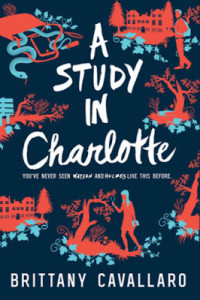Book Review: A Study in Charlotte
A Study in Charlotte
By Brittany Cavallaro
 Like so many novels before it, A Study in Charlotte finds boarding schools fertile settings for the mysteries of life, limb, and, quite frankly, inexplicably flexible attendance policies when the game is afoot. The boarding school of Sherringford is situated among “rolling green lawns and clear skies” in a patrician Connecticut neighborhood, a seemingly vast expanse. And yet, when a Holmes and a Watson are fellow students on its spacious grounds, the entire campus becomes too hot to handle.
Like so many novels before it, A Study in Charlotte finds boarding schools fertile settings for the mysteries of life, limb, and, quite frankly, inexplicably flexible attendance policies when the game is afoot. The boarding school of Sherringford is situated among “rolling green lawns and clear skies” in a patrician Connecticut neighborhood, a seemingly vast expanse. And yet, when a Holmes and a Watson are fellow students on its spacious grounds, the entire campus becomes too hot to handle.
Jamie Watson is a recent and hot-tempered transplant from London, invited to Sherringford on a rugby scholarship. The name is no coincidence: he is the great-great-great grandson of a certain Dr. Watson. Despite certain high-placed family connections, he has only heard of, never met, Charlotte Holmes, the many-generations-removed descendant of the world’s greatest consulting detective.
Their initial encounters are fraught. Watson is first introduced to Holmes over a poker game she runs; she barely acknowledges him. Subsequently, when a thuggish student yells epithets at Holmes, Watson, quite literally, lets his fists do the talking. Holmes, less than impressed, excoriates him:” You think you are defending ‘my honor,’ but you’re just as bad as he is….I can fight for myself.”
When that same student turns up dead shortly thereafter, in a Speckled Band—themed tableau, that statement is sorely tested. Holmes and Watson team up to solve the murder—not only because it is their familial and literary destiny, but because they find themselves framed in an ongoing series of crimes.
Much as the Sherringford campus (Cavallaro is generous with her Canonical names) seems endlessly capacious, like a New England Hogwarts, so too the plot of A Study in Charlotte contains multitudes. The frame, of course, is the murder mystery, but family drama, coming-of-age and keen adolescent frustrations are showcased as well. Charlotte Holmes and Jamie Watson show promise as partners and protagonists, but they are not yet fully realized. Many of Jamie’s interstitial moments, such as when he grapples with the unresolved relationship with his estranged father, who lives an hour away from Sherringford, are more affecting than the crime-solving partnership.
Much of the dialogue is rather leaden, which makes it difficult to fully engage with the characters; this flatness also renders the overt Sherlockian references throughout the novel—especially where Jamie pauses mid-action to comment upon how “this is just like (insert name of story here)!”—dutiful rather than natural.
As the first volume of a planned trilogy, Charlotte offers a range of Sherlockian references and an inventive setting. One hopes that subsequent volumes will see the Sherlockian canon serve as a springboard, not a straitjacket, for Cavallaro’s eminently enthusiastic take on one of the literary world’s most enduring partnerships.
A Study in Charlotte is available here.
A copy of this work was provided by the publisher. All opinions expressed are the reviewer’s own.

Tamar is an archivist (“Tamarchivist” is, obviously, her DJ moniker) and lover of research logistics, grammar, and Ping-Pong. Contact her on Twitter @Fitzgig.
I love both YA and Holmes, but I’m a little skeptical of the YA industry’s habit of churning out novels with same-ish plots and the latest fad setting or concept pasted on. But I was pleasantly surprised by this one! I agree at times that the characters seemed to be reminding the reader that we’re in a Holmes story. That being said, I found myself really captivated by the idea of what the present would look like in a world where the Holmes stories are historical and the Holmeses (and others) continue to manipulate things behind the scenes…while the original Holmes and Watson were still being the literary protagonists we know and love. (In that way, it reminds me a little of some of the exposition and backstory for Lestrade in Sherlock Holmes in the 22nd Century.) One of the minor problems I’ve had with modernizations of Holmes is that Sherlock Holmes is such a touchstone in pop culture that certainly something in the universe of Sherlock or Elementary would fill that gap. This kind of approach plays a bit with both ideas–Holmes as historical figure and what a “modern” Holmes would have to deal with today.
I’m hoping later books in the series will explore more of this worldbuilding,